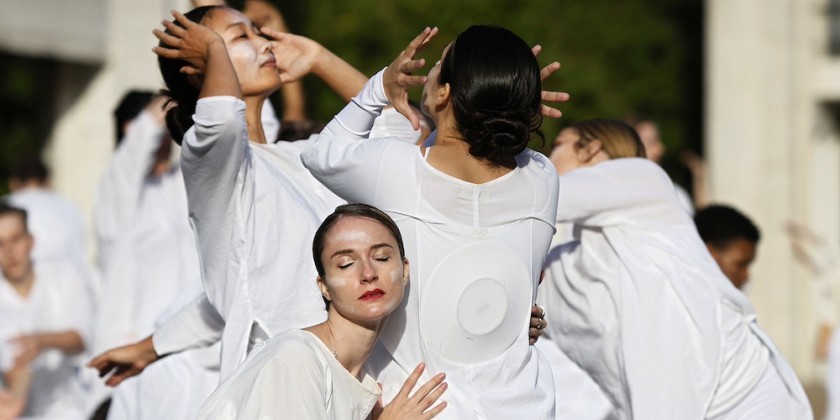IMPRESSIONS PLUS: Kinetic Light in “Under Momentum” Presented by Lincoln Center

Artistic Director, Performer, Choreographer: Alice Sheppard
Choreographer, Performer,Technology Creator: Laurel Lawson
Scenographer/Lighting Designer: Michael Maag
Visual Music: Joan Jeanrenaud
Ramp Platform Kit: Susan Hendren
Venue: The Clark Studio Theater, Lincoln Center, New York, NY
Dates: February 17 -19, 2023
Kinetic Light (KL), an internationally recognized disability arts ensemble, was conceived by the renowned, disabled dancer and choreographer, Alice Sheppard (she, her, hers). In 2016, Sheppard founded Kinetic Light as a place for disabled artists to create, design, and perform, working at the nexus of access, queerness, dance, and race.
I was privileged to attend the company’s performance on Sunday, February 19th, and on the following day, to have a Zoom session with Sheppard and her partner Laurel Lawson (flexible pronouns). They were extremely gracious in sharing their thoughts about their work and it was made clear by both Sheppard and Lawson that for Kinetic Light, “disability is not a deficit,” but “a powerful, intersectional creative force that is essential to artistry.”

Laurel Lawson and Alice Sheppard back to back in their wheelchairs on a wooden ramp; photo by J. Adam Fenster/University of Rochester
Sheppard envisions, choreographs and dances, and Lawson, also a choreographic collaborator and dancer, serves as the company's engineer and designer. Lawson has created innovative software apps for numerous programs, including Audimance, the company's approach to audio description, and Access ALLways, a holistic approach to disabled-led equitable access.
Both artists rely on the talents of another brilliant wheelchair artist, Michael Maag (he, his, him), their scenographer. Maag, a 20-year resident lighting designer for The Oregon Shakespeare Festival, has won numerous awards for his lighting, video, and projection for theatre, dance, musicals, opera, and planetariums. Unlike other artistic projects where the lighting person comes in to set the piece once it is complete, Maag is a part of the process from the beginning. His work enables Kinetic Light to tell stories.
Under Momentum celebrates the joy of continuous motion. Performed in wheelchairs, the wheels used are specifically turned at an angle, to create a greater ease of motion. The dancers virtuosic movements are generated and supported by Sara Hendren’s Ramp Platform Kit — work of art in its own right. Under Momentum, as a result, is breathtaking.

The piece builds from a series of partnering and solo work, beginning with minor physical contact and culminating with full-body interaction. Each artist has an opportunity to reveal their individuality. At one point, Sheppard balances on one knee with her other leg outstretched as she magnificently holds her wheelchair above her head. Lawson executes a wild wheelchair dance over a series of ramps with various inclines.
The presence of danger makes the audience hold their breath and become fully invested in the risk of the event. Partnering goes from tender to playful. At one point the artists, chase each other around the stage, clearly enjoying themselves and relishing taking us along for the ride.

The entire experience from entrance to exit was designed to be accessible for multiple, diverse populations.
There were ASL interpreters, before and during the program, as well as outside the theater, after the piece. As Lawson and Sheppard state, "Technology is used as a lever."
The audience is encouraged to respond however they wish. Many deaf and hard-of-hearing patrons stomped their feet and raised their hands overhead, shaking them with, fingers spread wide open — this is the traditional ASL sign for clapping. Other audience members joined in solidarity.
There was an option to enjoy the event via "haptic soundtrack interpretation," which refers to vibrations generated though wiring. The Haptic Experience Design was created by Laurel Lawson with thanks to David Bobier & Jim Ruxton of VibraFusionLabs. Lincoln Center's large print and Braille programs are made possible in part by endowment support provided by AIG.
%20and%20Laurel%20(right)%20clasping%20forearms.jpeg)
Alice Sheppard and Laurel Lawson dance around each other in a counterbalance turn; photo by J. Adam Fenster/University of Rochester
A "Chill Out" space was another interesting component to this performance. Audience members were able to leave and re enter the show as needed. This space contained sensory materials (offering a tactile experience) along with bean bag chairs and dim lights to provide a quiet place for showgoers.
When asked what Kinetic Light's plans are going forward, Sheppard says, “We're going to go back into the studio to explore and expand partnering and capacities to work."
It will be fascinating to see where this group goes next.









